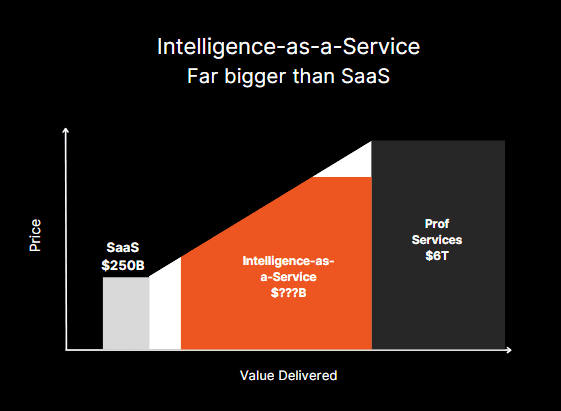
SaaS for days
Powered by billions in venture capital, the past 10 years has witnessed an explosion of SaaS offerings—over 30,000 of them according to Statista.
Most of us picture companies like Slack, Hubspot, Jira, Notion, Figma, etc. From self-service sign-up to free trial to one paid seat to many. Rinse and repeat.
Most tech and enterprise leaders conceptualize GenAI as simply SaaS 2.0. After all, most of the AI companies we talk to as VCs are exactly that—SaaS with an AI sticker on the box. Instead of “Intel Inside” it says, “Now with AI.”
While there will likely be many AI solutions that charge by the seat and look like SaaS in other ways, we think that there is a much bigger game that tech is just waking up to.
SaaS is pennies on the productivity dollar
Companies today pay +$250B for SaaS that makes work easier.
If a sales team religiously tracks all prospect interactions in a CRM, the team and leadership get help orchestrating outreach and providing accountability metrics.
If the AP team fills in the right details in a form, the ERP system rolls up that information so that cost accounting can predict margins more accurately.
If the dev manager populates Jira status updates, the team can stay more coordinated and accountable.
SaaS is great, but it doesn’t deliver outcomes—it assists. For their help, thousands of SaaS companies charge a toll that amounts to pennies on the dollar of the payroll costs of the teams who use the software. Let alone the value of the productivity outcomes these teams deliver and protect.
What if you could sell productivity outcomes? That dream is already reality—in the form of a ~$6T global industry called Professional Services. The scale of outsourced business services puts SaaS in its place. With the arrival of AI, what happens to the marketplace for productivity outcomes?
Intelligence-as-a-Service
Each week, we see more VCs waking up to a much bigger reality. Whether they call it cognition-as-a-service like our friends at Mayfield, or Service-as-a-Software like our friends at NFX, or Intelligence-as-a-Service like we have since last Fall, the smart money is starting to see AI as more than SaaS.
It is instructive to think about the bigger productivity mega market in the lens of price vs value. SaaS comes in as a low price but also low value position in this construct. Because it is mostly FormWare and databases that fit workflows, SaaS helps people do work. It’s far cheaper than humans, but also far less impactful in delivering productivity outcomes.
Professional Services, on the other hand, occupies the high price high value quadrant. We only ask humans to do tasks that deliver sufficient value—because humans are much more expensive. Even humans that live a world away. Tech enabled services certainly stretch into the no-mans land between, but with limitations.
We believe that GenAI Agent technology that delivers narrow, near human expertise will grow the productivity pie. This Intelligence-as-a-Service delivery will be consumed in a far more human manner than SaaS. It will feel much more like professional services, perhaps even offered in conjunction with human teams.

By creating more productivity at lower costs, a host of outcomes that companies and individuals want more of will potentially experience a Javon’s Paradox—when lowered input costs spur massive growth in demand, causing a counter-intuitive net increase in demand. A relevant recent example is how the torrent of new data available to analyze created a seemingly unquenchable thirst for business intelligence insights.
Does a self-service model make sense for Intelligence-as-a-Service?
OpenAI’s ChatGPT sub-$30 per month subscription seems like an existence proof that GenAI will be a race to the bottom. It’s an open secret that at this price, even moderate use becomes unprofitable for them. How will AI applications capture value?
While we are still in awe of how far GenAI has come, we’re here to remind you about the limitations of the all-powerful OpenAI model that kick-started the current hype wave. Even if you’ve used it a lot, GPT 4o does not:
Know/remember your job or company
Write code that you can ship without edits
Know when it might be wrong
Know that it uses the word “delve” too often
It will get better but it should be clear by now that you have to build on top of LLMs in order to create trustworthy, reliable domain expertise. Whether you call it a wrapper or not does not change the fact that companies delivering real, human-like experiences today are having to write a lot of code.
More Human = Higher Margins
Intelligence-as-a-Service may sound like a technology breakthrough, but we think it is just as much a go-to-market innovation.
Let’s look at Starbucks—an unlikely role-model for Silicon Valley. Starbucks took a commodity product and got consumers to pay 5x the price because Howard Shultz understood that there was a total human experience that could be transformed.
Consulting and Professional services have always been the masters of value-based pricing. While they have much higher costs than software, they can capture even higher total revenues at least partly because they tend to deliver end-to-end outcomes. AI-enabled tech will increasingly be held to that standard.
Breaking the seat-based pricing habit
Selling human-level value creation is all about delivering outcomes. If tech companies can make the shift in thinking from low seat/usage-based pricing, they will be rewarded in the new AI reality. Here are the ways that Intelligence-as-a-Service offerings can capture more value:
Having (some) human-delivered services is a feature not a bug
VCs typically tell SaaS leaders to avoid having professional services teams. In the new transformation, these teams will be critical to both helping clients see AI offerings as more than just a per-seat commodity and getting integrated into workflows that deliver human-level value. It also is likely that the journey to AI Agent-level impact requires more humans in the loop until the training wheels can come off.
Build relationships up the hierarchy
To navigate the coming shift to delivering and capturing more with AI Agents, tech companies will need to develop the ability to sell technology transformation. If that means transforming an organizational function, it may be challenging to get functional leaders to automate human tasks they have considered the basis for their team’s value. Tech company founders will need to lay the groundwork now to influence cross-functional leaders not just the most engaged functional champions.
Prioritize data
Both real and perceived AI Agent capability will be a function of the unique data that feeds them. Our advice to SaaS founders is that they carve out more time to create functionality that captures more critical data from their users. Existing SaaS businesses have an advantage compared to new entrants to the degree that they have captured more valuable information over longer time periods. This data capture is not just for quantitative data points. In many cases, the unlock of Generative AI is the ability to unlock the value trapped in unstructured text and images. The critical filter is thinking about outcome data. Who ended buying? What influenced a decision? Who was hired? What did the post-mortem show? These are the most valuable insights that haven't been able to be efficiently integrated into automated systems until now.
THOUGHT LEADERSHIP
© 2024 Vantage Point Inc. All rights reserved.








